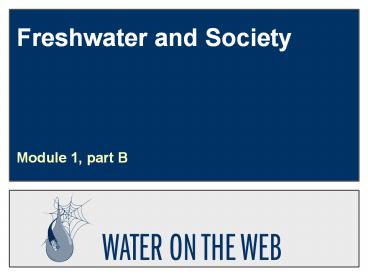Freshwater and Society - PowerPoint PPT Presentation
Title:
Freshwater and Society
Description:
Freshwater and Society Module 1, part B * Graphic from C. Svendsen Use this to review with the students the take home concepts of surface water, soil ... – PowerPoint PPT presentation
Number of Views:59
Avg rating:3.0/5.0
Title: Freshwater and Society
1
Freshwater and Society
- Module 1, part B
2
Watersheds
3
Hydrological cycle of a watershed
4
Watershed definition
- Watershed
- An area of land that drains water, sediment and
dissolved materials to a common receiving body or
outlet - The term is not restricted to surface water
runoff and includes interactions with subsurface
water - Watersheds vary from the largest river basins to
just acres or less in size
5
Organization of watersheds
- A divide represents the boundary of a watershed
- Larger watersheds can often be divided into
smaller units called subbasins, drainage areas,
or water resource inventory areas
6
Watersheds
7
Watershed components
- Latitude, albedo climate
- Geology
- Topography
- Land Use
- Vegetation and impervious surfaces
8
Watershed components Latitude
- Energy input into a watershed depends on solar
height and length of daylight hours - Determined by the latitude and season
- May 21, Seattle, WA solar altitude at noon is
62.500 - January 21, Seattle solar altitude at noon is
22.500
9
Watershed components Albedo
Albedo is the reflectance of a surface. The higher the reflectance the less energy input into a watershed. Albedo is the reflectance of a surface. The higher the reflectance the less energy input into a watershed.
Surface Cover Albedo ()
Water 5-10
Bare soil (light colored, dry) 20-35
Marsh and Bogs 15-20
Forest (dense spruce) 5-10
Forest (hardwoods in leaf) 15-20
Snow (fresh) 80-95
Snow (old) 40-70
10
Watershed components Climate
http//www.eia.doe.gov/emeu/recs/origin/climzone.g
if
- Temperature regime
- Relative humidity
- Precipitation patterns
http//www.epa.gov/ceisweb1/ceishome/atlas/nationa
latlas/climatezones.htm
11
Watershed components Climate
- Precipitation
- Temperature
- Relative humidity (RH)
- Wind
12
Watersheds Average annual precipitation
13
Watersheds Potential evapotranspiration
14
Watersheds Water surplus or deficit
15
Watershed components Geology
- Bedrock
- Type and distribution of soils
16
Geology Soil permeability
- The ease with which water penetrate or pass
through a bulk mass of soil or a layer of soil
17
Geology soil pore space and water content
- Total porosity of a soil determines maximum water
content at saturation soils within zone of
aeration are seldom saturated. - Textural (primary) porosity voids between
aggregates. - Structural (secondary) porosity voids
- within aggregates fracture or poor
- zones
http//wrgis.wr.usgs.gov/open-file/of99-168/Pp-lim
estone.jpg
18
Geology Groundwater vs. soil moisture
- Groundwater
- Subsurface water in the zone of saturation that
is free to move under the influence of gravity,
often horizontally to stream channels - Soil Moisture
- Subsurface water in the unsaturated zone held in
place by capillary forces or osmotic pressure
19
Geology moisture content of various soils
20
Geology Infiltration
- Infiltration is the flow of water downward
through the upper layers of soil
21
Geology infiltration capacity during a storm
22
Geology soil moisture profile after a rain event
23
Geology seasonal infiltration trends
24
Geology seasonal variation in watershed runoff
25
Geology Saturation and runoff generation
26
Watershed components Topography
- Topography
- Slope
- Aspect
27
Watershed components Topographic interactions
28
Watershed components Land use and vegetation
- Vegetation
- Slows runoff
- Reduces soil compaction
- Prevents soil erosion
- Reduces pace of raindrop splash
- Reduce soil material moving downslope
- Influences timing of snowmelt runoff
- Influences water yield
29
Land use Stormwater discharge vs. land use
30
Land uses Effects upon hydrology/water quality
- Natural Events
- Fires
- Wind storms
- Disease outbreaks
- Floods
- Volcanoes
- Climate change
- Land Uses
- Flood control
- Timber production
- Urban development
- Hydroelectric
- Agriculture
- Mining
31
Watershed components land Use
32
Organization of a watershed
33
Watershed Water budgets
- Water budget
- Evaluation of sources of supply vs. discharges
with respect to a drainage basin
34
Watershed Water budgets
- Annual water budget for Lawrence Lake, Michigan,
and Mirror Lake, New Hampshire
35
Watershed Water budgets
- Water budgets provide a graphic depiction of the
distribution of moisture throughout the year in
any given area - An idealized budget, however, is rarely achieved
- Examples from Los Angles, CA and Pullman, WA,
illustrate the range of potential deviation from
the ideal water budget
36
Watershed water budget Pacific Northwest
37
Watershed Aquatic ecoregions
- North America has been divided into eight major
aquatic ecoregions - Arctic rivers and lakes
- Large temperate lakes
- Temperate headwaters and lakes
- Large temperate rivers
- Endorheic rivers, lakes, and springs
- Xeric-region rivers, lakes, and springs
- Temperate coastal rivers and lakes
- Subtropical coastal rivers and lakes
38
Aquatic Ecoregions of North America
39
Watershed components































